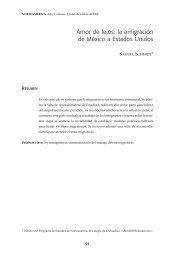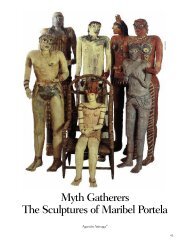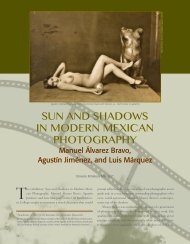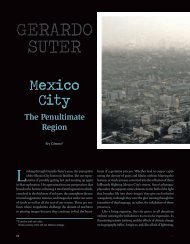Flower Body1 - Revistas
Flower Body1 - Revistas
Flower Body1 - Revistas
Create successful ePaper yourself
Turn your PDF publications into a flip-book with our unique Google optimized e-Paper software.
healer manipulates the polarities of the body through physical contact, her management of space,<br />
prayer, and the invocation of her supernatural helpers, the saints and the Virgin. For her, the human<br />
body is inscribed in a hierarchical polarity that creates two axes, one vertical and the other ho rizontal.<br />
Using the navel, siiku, as a refe rence, differentiated values are located: right (batataza), up<br />
(jikat), forward (bat), related to the east, or life; on the other side, the left (micoi), down (betukuni)<br />
and behind (amau), related to the west, or death. Thus, a healer’s altar must face the place where the<br />
sun rises because that is where light is born and there is life. It must not face the west because that<br />
means death. These positions are related to the way in which people are buried: the head must be<br />
facing east, and the feet, west, “because they must walk with the sun, from the time they are born<br />
until they die.”<br />
When a person recognizes him or herself as a healer, the saints and virgins, prayers, medicinal<br />
plants, incense burner, water, the egg, and the candle light can be replaced by his/her hands.<br />
Everything that constitutes the shrine and the altar is found in the body of the healer: the healer is<br />
the temple, the center. And for that reason, they say, we must follow the paths of God, regardless<br />
of whether we go to mass or not. The important thing is to do things right. The body is the church;<br />
every part has a task; the healer protects it with medicinal plants, and with the protector who is<br />
Jesus Christ.<br />
noTes<br />
1 Information for this article is from María Eugenia Olavarría, Cristina Aguilar, and Érica Merino, El cuerpo flor. Etnografía<br />
de una noción yoeme, Las ciencias sociales Collection (Mexico City: Miguel Ángel Porrúa/uam, 2009). This book was written<br />
with the support of the National Science and Technology Council (Conacyt) for the project “Kinship, Body, and Re production.<br />
Representations and Cultural Contents in the Context of Contemporary Mexico,” directed by María Eugenia<br />
Olavarría.<br />
2 The term yoeme is the generic ethnic name for Yaquis and Mayos; the Yaqui language variant uses yoeme for the singular<br />
and yoemem for the plural. In this text, we use the terms Yaqui and Yoeme synonymously.<br />
Chapayeca mask,<br />
used during Lent and Holy Week.<br />
79







